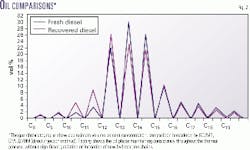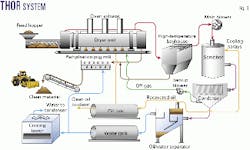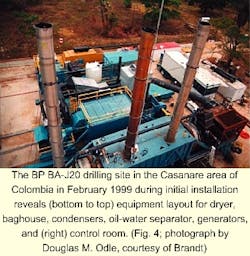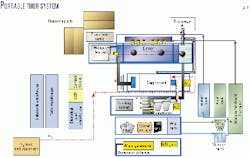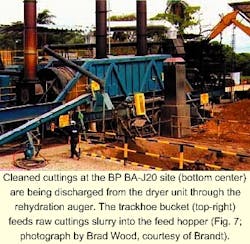A thermal desorption process used by BP in Colombia has proven efficient and cost effective in treating oil-based-mud (OBM) drilled cuttings.
Tuboscope subsidiary Brandt, Houston, specifically designed and customized its THOR (thermal oil recovery) system for oil-based-mud drilled cuttings. The system allows for maximum source reduction and minimum waste, recycling, and environmental impact.
BP estimates savings at close to $2 million/well while using thermal desorption. The following items contribute to the cost savings:
- Diesel recovered from the cuttings can now be used for new mud makeup (rather than fresh diesel).
- Drilling time is reduced through the use of oil-based mud vs. water-based mud.
- Thermal desorption is more economical than other treatment technologies in this particular case.1
Fig. 1 compares other technologies and their associated costs with thermal desorption.
History
Faced with rapidly tightening environmental regulations, oil companies are finding that the traditional methods of reducing oil on cuttings and some disposal methods for oil-based drilled cuttings are no longer acceptable.
The US Gulf Coast is moving towards zero discharge,2 and North Sea operators are required to reduce oil on cuttings (OOC) to less than 1 wt % by January 2001.
Land rig operators are finding similar stringent requirements, which lead to increased disposal costs for oily cuttings.
Thermal desorption has been used in the soil-remediation industry for decades. This process involves heating oil-contaminated solids past the vaporization point of the liquid, removing the liquids (oil and water) in a gaseous state, and either recovering or destroying them.
This process leaves the solids clean and oil-free.
Previous testing of these systems in the oil field has proven less than satisfactory.
Oil-based mud drilled cuttings are inherently abrasive and sticky and require high temperatures of vaporization due to the longer-chain hydrocarbons that can be present. Traditional thermal desorption systems were not designed to handle the high btu content of the oil, nor were the materials of construction adequate to handle the temperatures required.
Oil field operators who may have tried thermal desorption at some point in the past will probably attest to the fact that these systems were uneconomical, could not handle the required throughput, and were frequently out of service due to mechanical failures.
THOR system
The THOR system processes around 7,500 tonnes/month of OBM cuttings contaminated with 25-30 vol % oil and 25-30 vol % water. The raw influent requires no additional pretreatment before processing.
A water-treatment system is unnecessary because the water produced during the process is used in the desorption process for cooling, rehydration of discharge solids, and dust elimination, thus avoiding any water discharge to the environment.
The processed cuttings typically have fewer than 10 ppm of total petroleum hydrocarbons (TPH), and the oil quality far exceeds the results from other technologies. The solids content varies between nondetectable and 0.03% vol % (Table 1).
Laboratory testing has shown that the recovered diesel is remarkably similar in composition to the original diesel in composition and that it may be used in an identical manner.
For BP's Colombia application, the THOR system uses approximately 20% of the recovered diesel volume to fuel the thermal process, with the excess returned to BP. The company chooses to use the high-quality recovered diesel to make up new drilling mud (Fig. 2).
Colombian operation
The OBM drilled cuttings from various drilling locations around the Yopal, Casanare, area are transported in specially designed 12 cu m hermetically sealed dump trucks to the central thermal facility for processing. They are then placed in the steel-lined holding pits, which are used to store material for feeding the THOR unit.
Through a minimum of handling steps, BP ensures maximum logistical efficiency and reduced environmental risk while moving the cuttings from the field.
Once the cuttings are on the THOR processing location, Brandt personnel run a retort analysis and check mud weight to verify the condition of the material and update control documents before proceeding.
Cuttings are then lifted from the holding pit by a trackhoe and placed into the THOR system feed hopper several meters away (Fig. 3).
A variable speed auger in the bottom of the hopper pushes material into the stainless steel dryer at a rate of 15-20 tonnes/hr. The externally heated (indirect) rotary dryer shell rotates within a ceramic insulated refractory firebox designed to withstand internal temperatures of up to 2,200° F.
An integrated positive-sealing system on either end of the dryer shell allows for a slightly negative pressure within the system. Conductive heat transfer through the dryer shell heats the cuttings as they pass along the interior of the drum.
Movement of cuttings through the dryer is proportional to the angle of the dryer (+2°) and the speed at which the dryer rotates. Retention time of cuttings within the dryer is controlled based on moisture content and varies between 20 and 35 min.
Mixing flights and a special cleaning system within the dryer ensure a homogenous mixture and eliminate caking that may occur in the heat transition zones within the dryer.
The cuttings are heated to 550-800° F. before exiting the system; these temperatures ensure complete evaporation of the oil phase from the solids.
Hot processed cuttings leave the dryer through an airlock at the discharge plenum; they are rehydrated and cooled with processed recovered water in a soil conditioner (18 in. mixing auger with water sprays).
These processed inert "oil-free" solids are tested and transported approximately 1 km to the designated area for non-hazardous waste disposal.
The gaseous water and oil phase (evaporated from the cuttings in the dryer) passes through a high-temperature baghouse to remove dust and particulate. The particulate is collected on the outside of the filter bags and conveyed into the soil conditioner.
The "clean" gaseous stream is then condensed back into a liquid with a fin-tube condenser and a closed loop water-cooling tower. The oil and water (now in a liquid phase) are pumped by positive displacement pumps to an oil-water separator-coalescer. The recovered water is stored in a tank on location, to be recycled to the process as cooling and rehydration water.
Oil recovered from the process is stored in a 500-bbl "frac tank" that provides fuel for 40-MMbtu primary burners to heat the process. The oil that is not required for the process (more than 80% of the recovered total) is pumped to storage tanks on location for use by BP to make up new drilling mud.
For each tonne of cuttings processed in Colombia, the system recovers approximately 0.61 bbl of diesel fuel valued locally at $53/bbl. At an average 275-tonnes/day process rate, this equals $8,890/day savings to BP.
Recovery of synthetic or mineral oils can yield substantially greater savings.
Operation
The THOR system (Fig. 4) has been operating for BP Colombia since early 1999. During its first year of operation, the system successfully processed more than 78,000 tonnes of oil-based mud drilled cuttings (approximately 250,000 bbl), and recovered more than 41,000 bbl (1,722,000 gal) of oil that would have previously been fixated with lime and most likely retreated again later.
Independent stack testing has shown air emissions are well below the standards set forth in the EPA 1990 Clean Air Act and more than 90% less than local Colombian emission standards.
As the oil associated with the cuttings does not come in contact with an open flame, the actual emissions are the byproducts of combustion from the burners only, which are tuned to achieve close to stoichiometric conditions.
Actual system throughput depends on the initial moisture content of the cuttings. Water takes a significantly higher percentage of btus to evaporate than does oil (Fig. 5).
As shown in Fig. 6, the portable THOR system operates 24 hr/day with shutdowns for regularly scheduled maintenance. The footprint of this particular installation is approximately 100 sq ft.
Not only has the THOR system (Fig. 7) allowed BP Colombia to realize greater economical savings, there are many social and environmental benefits associated with this operation, including:
- Reduction of waste transportation
- Reduction of land requirements
- Shorter treatment time
- Reduction or elimination of long term environmental liability
- Maximization of recycling
- Less pollution to the environment
- Better community relations with the creation of new job opportunities.
References
- Wood, B., and Rojas, J.C., "Indirect thermal desorption in South America: a new solution for oil-based drilled cuttings disposal," Soil Sediment & Groundwater, July 2000.
- 40 CFR 435.
The authors
Brad Wood is Brandt's operations manager for Latin America, based in Houston. He has worked for Brandt for more than 10 years. He is also involved with design, development, sales, and operations of Brandt's thermal desorption systems. Wood has a background in electronics and is now working on a masters in environmental management at Chadwick University, Alabama.
Efrain Casadiego L. is BP's fluids and environmental engineer for drilling operations in Colombia, based in Bogotá. He has worked for BP for more than 6 years. He started as a fluids engineer for Baroid 19 years ago and worked almost 10 years for Baker Hughes Inteq in Colombia and several other assignments in Latin America and the US. Casadiego L. graduated in petroleum engineering in 1981 from the Universidad de América in Bogotá.



